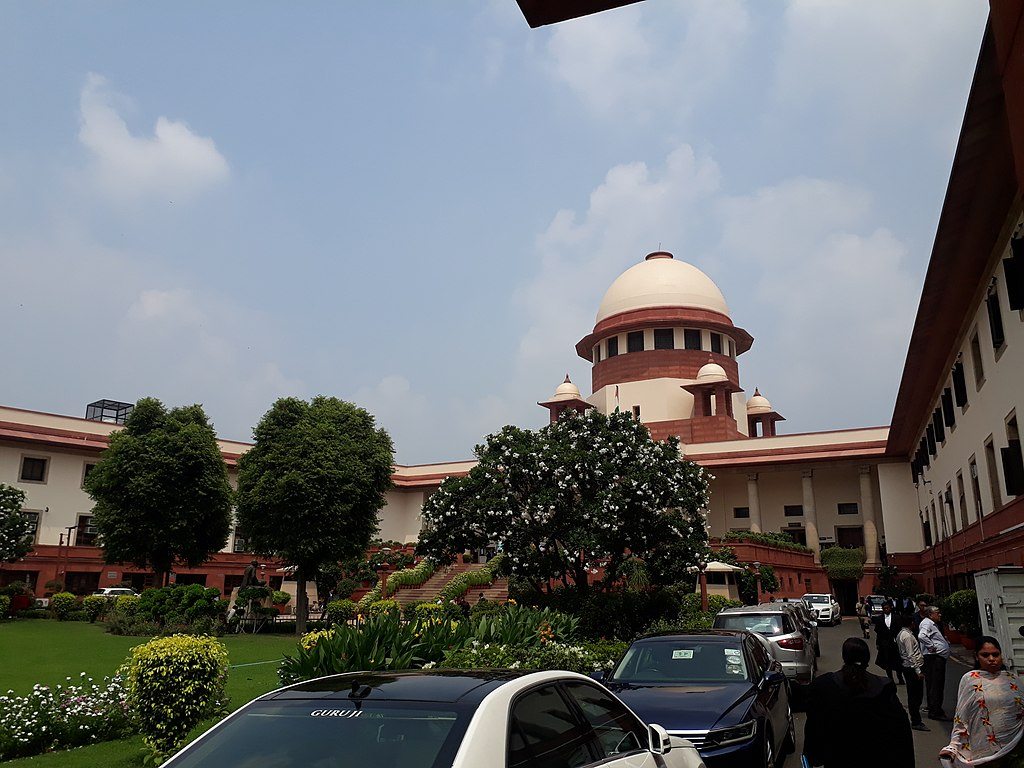India’s Justice System Is No Longer Independent: Part I

Published by The Lawfare Institute
in Cooperation With

Indian Prime Minister Narendra Modi achieved a significant diplomatic feat this summer with his state visit to the United States, which was followed by an honorary role at France’s annual Bastille Day celebration. As the global spotlight shifted to New Delhi, which hosted its first Group of 20 summit on Sept. 9, some leaders replaced open-armed embraces with expressions of concern over the trajectory of India’s democracy.
Since Modi’s election in 2014, his political celebrity has been on the ascent, but India’s democracy has been on a disconcerting decline. In 2021, Freedom House downgraded India’s status from a free democracy to a “partially free democracy.” The V-Dem Institute went even further, categorizing India as an “electoral autocracy” and placing it in a category alongside its historical rival, Pakistan—an unsettling development for many Indians. Furthermore, India’s global Democracy Index ranking slipped from 27 in 2014 to 46 in 2022 as a result of democratic backsliding, according to the Economist Intelligence.
Democratic backsliding under Modi has taken on many forms—cracking down on political dissent and the free press, intimidating political opponents, vilifying ethnic and religious minorities, and revoking the autonomy of the Jammu and Kashmir territory (over which India, China, and Pakistan struggle for control), to name just a few. All of these issues have been covered by Western journalists, most notably by the BBC, in its two-part documentary “India: The Modi Question”—which the Modi government has banned by invoking emergency law. A common thread tying these issues together, beyond Modi himself, is India’s judiciary and its complicity in facilitating the country’s slide toward authoritarianism.
In well-functioning democratic systems, the judiciary plays a crucial role as a counterbalance to autocratic tendencies. But the Modi government has deftly deconstructed the scaffolding of the judiciary by refusing to appoint judges, influencing the outcome of watershed cases, quashing political opponents using the executive’s leverage in courts, and capitalizing on judges’ self-interest and identity politics. The court’s management of the citizenship verification project in the state of Assam and the lawsuits initiated by the ruling Bharatiya Janata Party (BJP) against leaders of opposing political parties serve as stark examples of the dismantling of the judiciary’s scaffolding in Modi’s India.
Regrettably, the erosion of judicial independence in India is a critical aspect of India’s descent into authoritarianism that has largely been glossed over by Western media. The world’s most populous democracy now grapples with a weakened system of checks and balances, where the courts effectively act as instruments of the central government.
While Western attention has understandably centered on Israel, a crucial U.S. ally in the Middle East where similar trends have emerged, it is equally essential to scrutinize India’s parallel journey. The burgeoning alliance between the U.S. and India is evolving into a deeper and more substantial partnership. Concurrently, India is steadily moving toward a sectarian democracy—characterized by the majority group’s efforts to preserve a Hindu nation, while the international community largely remains silent—bolstered in part by India’s judiciary. In light of these developments, it is especially imperative to analyze India’s concerning political transformation.
In this article, I offer a primer on the structure of India’s judiciary and the moment its justices sounded the alarm about Modi’s rule, alerting the nation and the world to institutional erosion within the justice system. I provide deeper analyses of the state of India’s judiciary and the erosion of its independence in Parts II and III.
To grasp what went wrong with India’s courts, it’s important to understand the fundamental structure of the judicial system. India’s judiciary exists in a centralized ecosystem. Unlike the United States’s federal system of government, in which states and the federal government share power, power is concentrated in the hands of the central government in India. The judiciary, for its part, has a pyramidal structure, similar to that in the United States, with the district and subordinate courts at the bottom, followed by the high courts, and the Supreme Court at the top.
District-level judges are appointed by the governor of a state in consultation with the high court in that state. They are the first arbiters of justice in criminal or civil matters and have oversight from the high court in their state.
There are 25 high courts in India, approximately one in each state. In addition to supervisory jurisdiction over the district courts in their states, high courts also have appellate jurisdiction over the cases that come out of these district courts. And they have original jurisdiction over matters concerning the enforcement of fundamental rights. High court judges are appointed by the president after consultation with the chief justice of India’s Supreme Court (CJI), the governor of the state, and the chief justice of the high court. Their tenure is limited to the age of 62, at which point they must resign.
A similar framework is in place for the Supreme Court under India’s Constitution, but a different procedure prevails in practice.
Under Article 124, the Supreme Court of India is composed of the chief justice of India and 25 other justices, all appointed by the president “after consultation with … the Judges of the Supreme Court and of the High Courts in the States as the President may deem necessary.” For any appointment other than the post of CJI, the CJI must also be consulted. Technically, to qualify for an appointment to the Supreme Court, one must be a judge on one or more high courts for at least five years, have been an advocate in one or more high courts for at least 10 years, or be a “distinguished jurist” in the opinion of the president. Once appointed, Supreme Court justices have limited tenure: They must retire from their post at the age of 65.
In practice, though, the Supreme Court has wielded significant control over Supreme Court appointments since at least 1993 through the Collegium system. The Collegium is the technical name of the group of judges, comprising the four senior-most judges and the CJI, that make judicial appointment recommendations to the central government. Pending serious suitability or security concerns, the prime minister has historically approved the Collegium’s recommendations. Even in the case of suitability or security concerns, the government has returned the recommendation to the Collegium for clarification or reconsideration. If, after reconsideration, the Collegium reiterates the same candidate for appointment, the government is bound to accept the recommendation.
The Supreme Court has original, appellate, and advisory jurisdictions in India. This means the Supreme Court carries out roughly six functions, the first four being congruent to the functions carried out by the U.S. Supreme Court: upholding and interpreting the Constitution (Article 133), reviewing cases on appeal that involve a substantial question of law (Article 133), resolving interstate disputes or disputes between the states and the Union through its powers of original jurisdiction (Article 131), and protecting fundamental rights (Article 32). But where things get hairy is in the various constitutional mandates that reinforce the concentration of power in the central government and promote the commingling of the three branches of government by authorizing the judiciary both to assist the legislatures in lawmaking and to play an advisory role for the executive.
Known as “judicial lawmaking,” the first of these two mandates implicitly authorizes the judiciary to create new laws from the bench when the enacted laws are inadequate to meet the ends of justice (Articles 13, 32, 226, 141). The 1991 Supreme Court trust and estates case of Rattan Chand Hira Chand v. Askar Nawaz Jung underscores the court’s authority as judicial lawmakers:
[N]or is it realistic to expect that [legislatures] will have provided for all contingencies and eventualities. It is, therefore, not only necessary but obligatory on the courts to step in to fill the lacuna. When courts perform this function undoubtedly they legislate judicially. But that is a kind of legislation which stands implicitly delegated to them to further the object of the legislation and to promote the goals of the society. … All courts are at one time or the other felt the need to bridge the gap between what is and what is intended to be. The courts cannot in such circumstances shirk from their duty and refuse to fill the gap.
Far from being criticized as “activism,” caution Indian legal scholars, this form of judicial lawmaking is an accepted part of the system. It “aims at evolution” to keep pace with the “changing needs of modern society” that Parliament may not be able to address quickly enough.
In a similar vein, the second of the two hairy mandates is the Supreme Court’s formal “advisory jurisdiction.” Under Article 143, the president is permitted to consult the Supreme Court “[i]f at any time it appears to the President that a question of law or fact has arisen, or is likely to arise, … of such a nature and of such public importance that it is expedient to obtain the opinion of the Supreme Court … and the Court may … report to the President its opinion.” In carrying out this mandate, the judiciary plays an “advisory” role; its opinions are not binding on the president, nor do they become law.
The commingling of the three branches of government casts a shadow on the integrity of the Constitution as a tool to safeguard democracy in India because the three branches of government are, by design, inherently interlinked rather than entirely separate and independent. Consequently, this interconnectedness poses a potential threat to the apolitical nature of the judicial branch, leaving it susceptible to political capture.
Indeed, this is precisely what has transpired. The Indian justice system has lost its ability to operate impartially, rendering it incapable of serving as the ultimate bulwark against the erosion of democratic values.
The pivotal moment came in 2018, four years after Modi assumed office, when the four senior-most members of the Supreme Court after CJI Dipak Misra—Justices Kurian Joseph, Jasti Chelameswar, Madan Lokur, and Ranjan Gogoi—took an unprecedented step and held a press conference to divulge the external influences over the judiciary and Misra’s complicity in the matters.
This move signaled a recognition of and a reckoning with the attempted fundamental shift in India’s interbranch power balance and process of governance. Notwithstanding India’s institutional decay, it is—by constitutional standards—a democracy, not unlike the United States.
Imagine if the four senior associate justices of the U.S. Supreme Court—Justices Clarence Thomas, Samuel Alito, Sonia Sotomayor, and Elena Kagan—held a fireside chat on C-SPAN, or wrote an op-ed, suggesting that the president of the United States or his political party were meddling in Court matters. Not only would the integrity of the institution of the Supreme Court be questioned. There would be riots.
But no such thing happened in India. There was a substantial amount of debate, discussion, and concern within India’s legal and political circles, as well as in the media. But that didn’t fully capture the general public’s attention. Nor did the justices’ three grievances: (a) Modi’s refusal to finalize the memorandum of procedure for judicial appointments; (b) external influences over Misra and his handling of the investigation of Judge Brijgopal Harkishan Loya’s untimely death; and, relatedly, (c) Misra, as “master of the roster,” assigning politically salient cases or cases involving the BJP to sympathetic benches.
These three issues were ominous in no small part because they forewarned the three scaffoldings the Modi administration was deconstructing to weaken the judiciary’s might. “All four of us are convinced,” Justice Chelameswar stated, “that unless this institution is preserved and it maintains its equanimity, democracy will not survive in this country.”




